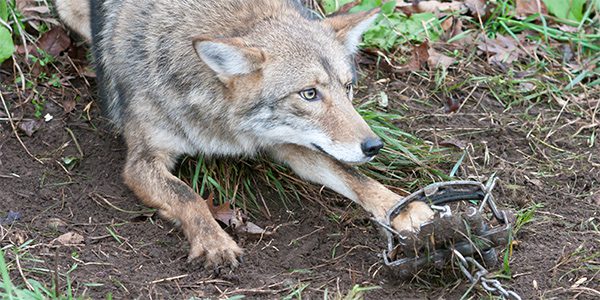Photo credit: Dollar Photo Club
Wolverine (Gulo gulo) | ESA status: threatened (North American subspecies Gulo gulo luscus, contiguous U.S. population)
Wolverine
Elusive denizens of frozen mountaintops, wolverines are celebrated as powerful, all-terrain, all-season masters of the icy North. Also called “mountain devil” and “carcajou” (French for “evil spirit”), wolverines are perfectly adapted to—and strictly limited to—their high-elevation habitats. Using their large, crampon-clawed feet, wolverines will travel miles through deep snow and rough terrain in search of food, mates, and a home.
A member of the weasel family, the wolverine resembles a small bear with a bushy tail. It has a thick, dark, oily double coat of fur that protects it from extreme cold. Some individuals have a light, silvery facial mask and pale buff stripes that run laterally from each shoulder down the sides and connect at the rump just above the tail. Wolverines have short, powerful legs, and all four feet have five toes with long, curved claws used for digging and climbing. Adult males weigh between 26 and 40 pounds; females are smaller, weighing between 17 and 26 pounds.
Wolverine diet
Wolverines need a lot of space to find enough food to meet their high caloric needs in their relatively unproductive habitat—the average home range for males in Idaho is 588 square miles. Wolverines are opportunistic feeders and will consume a variety of foods, depending on availability. They primarily scavenge on carrion—even crunching the bones of carcasses that grizzly bears leave behind—but also prey on small animals and birds and eat fruits, berries, and insects. Food scarcity is a primary limitation on wolverine reproduction. Females will not become pregnant until age two and commonly reabsorb or spontaneously abort litters when resources are limited. Females may only breed every other year so as to save energy resources needed for winter survival in extreme temperatures.
Wolverine habitat
Wolverines are found throughout the Northern hemisphere. In North America, they live in boreal forests, tundra, and alpine habitats throughout Alaska and Canada. The southern portion of their range includes alpine regions in Washington, Oregon, California, Idaho, Montana, Wyoming, Colorado, and Utah. Female wolverines require a stable snowpack late in the warm season for denning and successful reproduction. This means that in the southern portion of their range, where ambient temperatures are warmer, wolverines are confined to only the coldest, highest elevations.
What are the threats to wolverines?
The wolverine is fierce: it can kill prey many times its size and will defend food against much larger competitors. But while this ultimate survivalist is more than capable of providing for itself, it has no defense against climate change or traps. Global warming is reducing wolverine habitat and now threatens to extirpate the species in the United States south of the Canadian border. Trapping is an additional threat to the tiny population in Montana.
Climate change
Climate change is a primary threat to wolverines. Increasing temperatures melt winter snow more quickly in spring, hindering denning and reproduction. The loss of snowpack further diminishes the small, patchy habitats remaining in the lower 48 states, and reduces connectivity between isolated populations. High-elevation alpine forests are also expected to shrink and shift northward as the climate warms, further stressing wolverines.
Trapping
In Montana, wolverines are still trapped and killed for their fur, or are caught in traps intended for other species. Trapping can completely eliminate a local population of wolverines. In one instance, trappers killed two pregnant females and four adult males in a region, which resulted in the loss of the entire subpopulation. Losses of individual wolverines to traps restrict gene flow and hinder population growth in the overall population.
What WildEarth Guardians is doing to save the wolverine
Fewer than 300 wolverines are estimated to remain in the lower 48 states. Conservation organizations first petitioned to list the species as “threatened” or “endangered” in the contiguous United States in 1995. After years of legal wrangling, the U.S. Fish and Wildlife Service proposed to list wolverines in 2013, but withdrew the proposal in 2014. Guardians and partners successfully challenged the withdrawal in court, and the U.S. Fish and Wildlife Service must reexamine the decision.
Experts agree that wolverines must be restored to the Southern Rocky Mountains, particularly in Colorado, where at least some habitat will likely remain at high elevations despite global warming. Guardians supports well-planned wolverine restoration in this state, and addresses threats to the species, including sprawl, poisonous sodium cyanide M-44 traps, and other factors.
Historical Significant Actions
Wolverines listed as “threatened” under Endangered Species Act after 20-year conservation effort November 29, 2023
Court again forces feds to reconsider wolverine protections, this time using science May 26, 2022
Guardians and allies win lawsuit challenging flawed wolverine listing denial April 2016
Guardians and allies notify U.S. Fish and Wildlife Service they will sue to challenge flawed wolverine listing denial August 13, 2014
Guardians and allies call out U.S. Fish and Wildlife Service for withdrawing wolverine listing August 12, 2014
U.S. Fish and Wildlife Service announces 6-month extension on the final listing determination for the wolverine February 2014
U.S. Fish and Wildlife Service proposes to list the wolverine as “threatened” February 2013
WildEarth Guardians and seven other organizations, represented by Western Environmental Law Center, sue Montana for permitting trapping of wolverines October 12, 2012
WildEarth Guardians and partners petition the State of Montana to end wolverine trapping July 31, 2012
Wildlife Press: Wolverine
Nez Perce-Clearwater Revised Forest Plan fails wildlife, climate, and the public
Conservationists demand changes during three-day objection meeting
Read more >